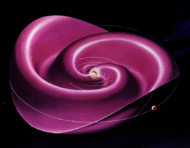
Back Sonvlam Afrikaans Erupción solar AN اندلاع شمسي Arabic Erupción solar AST Flare (astronomiya) Azerbaijani Сонечная ўспышка Byelorussian Слънчево изригване Bulgarian সৌর শিখা Bengali/Bangla Sunčeve baklje BS Erupció solar Catalan

| Part of a series of articles about |
| Heliophysics |
|---|
 |
A solar flare is a relatively intense, localized emission of electromagnetic radiation in the Sun's atmosphere. Flares occur in active regions and are often, but not always, accompanied by coronal mass ejections, solar particle events, and other eruptive solar phenomena. The occurrence of solar flares varies with the 11-year solar cycle.
Solar flares are thought to occur when stored magnetic energy in the Sun's atmosphere accelerates charged particles in the surrounding plasma. This results in the emission of electromagnetic radiation across the electromagnetic spectrum.
The extreme ultraviolet and x-ray radiation from solar flares is absorbed by the daylight side of Earth's upper atmosphere, in particular the ionosphere, and does not reach the surface. This absorption can temporarily increase the ionization of the ionosphere which may interfere with short-wave radio communication. The prediction of solar flares is an active area of research.
Flares also occur on other stars, where the term stellar flare applies.
© MMXXIII Rich X Search. We shall prevail. All rights reserved. Rich X Search